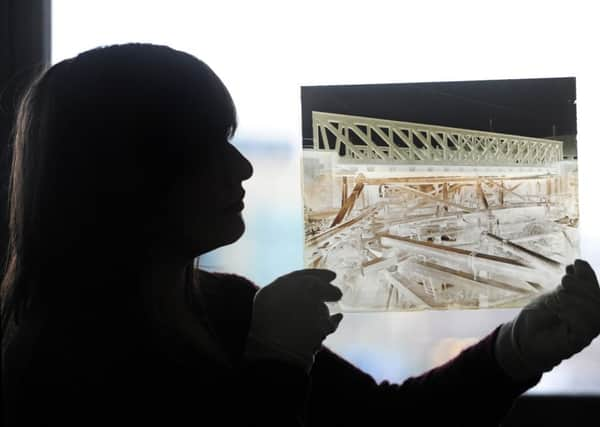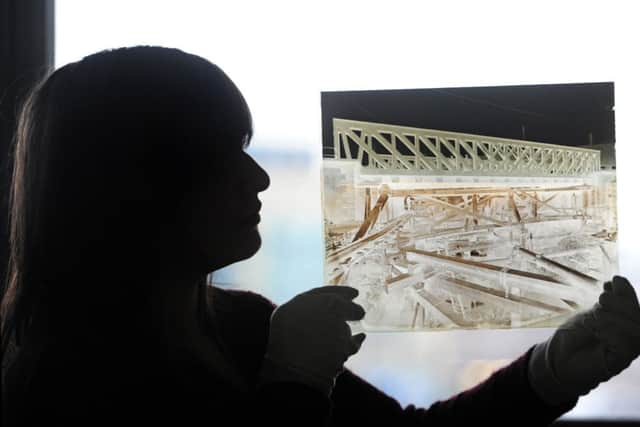Through a glass: A century of life in Doncaster


That was the challenge given to Doncaster College students and their stunning results are now on display in Doncaster Minster.
The exhibition started with a conversation between Evan Wood, who teaches photography at Doncaster College. and Dr Charles Kelham, principal archivist at Doncaster Archives over how the huge wealth of resources held by the archives could be brought to the public’s attention.
Advertisement
Hide AdAdvertisement
Hide AdEvan suggested his class could help put images from the area on display and at the same time learn about the importance of ‘contextualisation’ in photography - how photographs link to their time and place.


After all, these negatives belong to photographers active over a century ago, when Edward VII was on the throne and the Titanic was going to show the world the future.
The negatives used were created by prolific Doncaster photographer Luke Bagshaw.
Covering a wide range of subjects, it is though the photographs printed for the exhibition may never have been seen before. So far the students have revealead images of the town centre, family portraits and the construction of the canal as well as St George’s Bridge.
Advertisement
Hide AdAdvertisement
Hide AdThe only photograph in the exhibition with a date is of the local law clerks in 1913, however the material used goffers some tantalising hintsof when they were taken.
Glass was used for negatives until the 1920s when it was replaced by film. The delicate glass plates were slid into cameras themselves - a far cry from the cameraphones most people shove in their pockets today.
“It’s quite scary dealing with glass negatives that have a lot of history behind them, because we’re aware that they are breakable and irreplaceable,” said photography student Roberta Brackenbury, “so we handle them with great care.”
Fellow student Lauren Taylor added: “It’s exciting to see the pictures appear for the first time in the developer.”
Advertisement
Hide AdAdvertisement
Hide AdTheir course leader Evan explained that the Imperial Glass Plates range in size from around 5x7 inches to 10x12 inches.
These contact prints are converted into photographs of the same size - the college would need new machinery to be able to reproduce them at a larger scale.
When asked how many negatives are available at Doncaster Archives, Evan laughed.
“A lot! Ten years’ worth.” The project has been so successful and popular among the students that it is going to continue year after year and there are easily enough negatives on hand for another decade.
Advertisement
Hide AdAdvertisement
Hide Ad“The project is aimed to go towards a bid to the Heritage Lottery Fund in the long run - to build a display. The aim is to digitise the work of Luke Bagshaw and make it available to the public with the aim of building a contemporary photographic narrative of South Yorkshire. These photos are the foundation.”
The students have their work cut out. They are also tasked with identifying the places, objects and people in the images. Even small changes can make a significant difference to the look of a place, Evan explaind.
For example, well-known buildings and gardens can cause confusion just because in the photographs they still have their iron railings. Subsequently removed and melted down as part of the war effort, we are used to not seeing them. The images were also taken when Doncaster’s coal mining industry was on the up. As Evan explained: “Young people now wouldn’t have any idea how it looked before the decline”.
So far, putting the photographs on public display has gathered more opinions on the photographic techniques used, rather than historical context for what is in the pictures.
Advertisement
Hide AdAdvertisement
Hide AdThis leads to the next part of the project: documenting the South Yorkshire area today. While digital technology means more photos are being taken than ever before, they are not necessarily being entered into any official archive that will keep them safe for future generations.
Doncaster Libraries are accepting local photography from past and present to add to the archives. People are being invited to visit theirlocal library for more information on how your photos can go down in history.
The students’ exhibition runs until Saturday. February 15, at Doncaster Minster’s Forman Chapel.